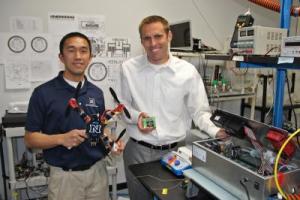Mar 7 2014
With a new contract from the U.S. Army, the University of Nevada, Reno is partnering with NevadaNano to develop a robotic flying vehicle that can be used for environmental health and safety monitoring of large areas.
 University of Nevada, Reno mechanical engineering researcher Kam Leang, left, and Ben Rogers of NevadaNano received funding recently from the US Army to develop a robotic flying vehicle that can be used for environmental health and safety monitoring of large areas. (Credit: Mike Wolterbeek, University of Nevada, Reno)
University of Nevada, Reno mechanical engineering researcher Kam Leang, left, and Ben Rogers of NevadaNano received funding recently from the US Army to develop a robotic flying vehicle that can be used for environmental health and safety monitoring of large areas. (Credit: Mike Wolterbeek, University of Nevada, Reno)
The project combines the autonomous systems expertise of the University with the unique sensor technology NevadaNano has developed for chemical sensing.
"A flying robotic platform capable of performing this type of in-flight analysis is not currently available," Kam K. Leang, mechanical engineering associate professor and the University's lead scientist on the project, said.
The goal of the proposed program is the development of a flying robot with integrated chemical sensing, inter-unit communication and the potential for self-powering. It will be able to "swarm" with other similar units to monitor, collect and analyze samples while in flight and relay data immediately.
The flying robotic platforms Leang has been developing in the lab may evolve to a highly versatile system to carry a number of payloads, beginning with this autonomous environmental detection system, for a wide variety of applications. NevadaNano's sensor system, with a sensor chip about 1 mm x 1 mm currently installed in a housing about the size of a shoebox, is rapidly being reduced in size and will eventually be about the size of a deck of cards, with the sensing system integrated into the construction of the flying robot.
"This project is an ideal collaboration," Ben Rogers, the project leader at NevadaNano, said. "We have the University's world-class research labs and researchers a few minutes away, so our pace of collaboration is accelerated. We can meet face-to-face daily if we want. This type of program is designed to leverage the University's facilities, expertise and personnel, and accomplish more than a small business might on its own."
NevadaNano is a start-up company that grew out of the University of Nevada, Reno in 2004 with a new lab-on-a-chip technology for comprehensive detection of trace chemicals and explosives in air. The company was founded by Jesse Adams and Ralph Whitten, who, along with Ben Rogers, Steven Malekos and Lee Deal, make up the NevadaNano team partnering with Leang on the flying robot sensor.
"This is an exciting project between the University and one of our very own, home-grown companies," Leang said. "The outcomes will impact Nevada's economy as well as help make the state and the University a leader in the field of autonomous systems."
The $150,000 Phase I proof-of-concept contract from the U.S. Army, titled "Autonomous Broad Spectrum Environmental Sentinels," is a Small Business Technology Transfer, or STTR, program. STTRs are federally funded programs that support companies pursuing innovative technologies.
In Phase I the team will complete several tasks:
- have a robot hovering autonomously with a dummy sensor load
- have a functioning chemical threat sensor
- demonstrate the working, combined robot/sensor system
- final design of the combined drone/sensor prototype to be built in Phase II
Phase I is expected to be completed in July. Based on the success of Phase I and availability of funds, Phase II will follow with construction and field testing of a prototype. A final product would be completed in Phase III.
The final platform will detect environmental threats in vapor form using interchangeable, onboard sensors. Utilizing the real-time data collected and analyzed by these sensors, the unit will be capable of swarming with other units during surveillance of a given area to, for example, localize and profile a contaminant source, such as toxic industrial chemicals and materials, semi-volatile and volatile organic compounds (pesticides, ammonia and explosives), and chemical or biological agents.
The rapid advancement of flying and hovering robots, often referred to collectively as drones, is enabling myriad applications in military reconnaissance, surveillance, law enforcement, hazardous waste inspection/removal, space exploration, recreation and entertainment, disaster search and rescue operations and remote sensing and mapping.
NevadaNano and the University of Nevada, Reno both agree the timing of the contract could not have been better considering the Federal Aviation Administration's recent designation of Nevada as a UAS test site, the launch this semester of the University's new UAS minor degree and plans for the University's new advanced autonomous systems innovation center moving ahead.
"The College of Engineering has made the area of advanced autonomous systems a strategic area of focus and growth in educational, research and outreach productivity," Manos Maragakis, dean of the College of Engineering, said. "This is an area of research and development with huge potential for the economic growth of our region. One of the main reasons is the autonomous aerial systems, which have generated a rapidly growing interest in our state's existing and future industry.
"This project presents a partnership between the University and industry to address a problem of national importance and aligns perfectly with our vision and efforts in the area of autonomous systems. We will continue pursuing more projects and partnerships of this type."